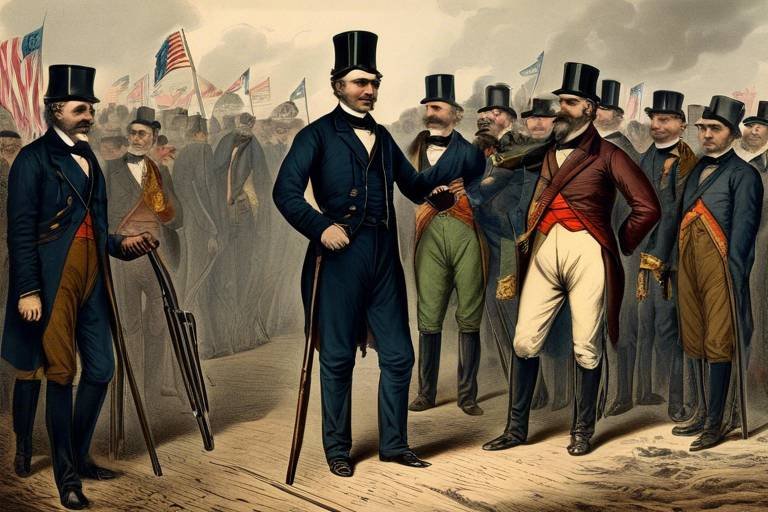The Contributions of Ancient Civilizations to Modern Society
Ancient civilizations have left an indelible mark on the tapestry of modern society, weaving threads of innovation, knowledge, and cultural practices that continue to shape our world today. From the towering pyramids of Egypt to the philosophical musings of Greece, each ancient civilization has contributed unique insights and advancements that have stood the test of time.
One of the earliest cradles of civilization, Mesopotamia, birthed groundbreaking developments in writing, mathematics, and urban planning. These foundational achievements laid the groundwork for the complex systems and institutions that form the backbone of modern societies. Imagine a world without the numerical system or the written word – Mesopotamia's legacy echoes through the corridors of time.
Ancient Egypt stands as a testament to architectural prowess, religious beliefs, and advancements in medicine and agriculture. The grandeur of the pyramids, the mystique of the Sphinx, and the intricate knowledge of herbal remedies all speak to a civilization deeply connected to the spiritual and the scientific. Their influence reverberates in art, spirituality, and medical practices still in use today.
Turning our gaze to ancient Greece, we encounter a treasure trove of philosophical ideas, democratic principles, artistic achievements, and scientific contributions. The birthplace of democracy and the cradle of Western philosophy, Greece's legacy permeates politics, culture, and intellectual discourse in the contemporary world. The echoes of Socrates, Plato, and Aristotle still whisper through the halls of academia.
Ancient Rome, with its legal systems, engineering marvels, military strategies, and cultural assimilation, left an indelible mark on governance, infrastructure, and social norms. The legacy of Roman law, the engineering prowess of aqueducts and roads, and the military strategies that shaped empires continue to influence modern civilizations in myriad ways.
Ancient China's inventions, philosophical teachings, governmental structures, and artistic traditions have cast a wide net of influence over global trade, governance models, ethical principles, and artistic expressions. From the compass to Confucianism, China's contributions resonate in the fabric of international relations and cultural exchange.
The Indus Valley Civilization, with its urban planning, sanitation systems, trade networks, and script, showcases a sophisticated society that thrived thousands of years ago. Their innovations in city design and commerce have left a lasting impact on modern urban development and communication technologies, underscoring the enduring legacy of ancient ingenuity.
The Maya Civilization's mathematical prowess, astronomical knowledge, agricultural practices, and artistic expressions illuminate a rich tapestry of contributions. Their advancements in calendar systems, sustainable farming methods, and artistic symbolism continue to shape our understanding of time, agriculture, and artistic expression.
Finally, the Inca Empire's architectural wonders, agricultural techniques, administrative systems, and cultural traditions paint a picture of innovation and resilience. Their legacy in construction, farming practices, and governance serves as a testament to the enduring impact of ancient civilizations on modern infrastructure, agriculture, and cultural heritage.

Ancient Mesopotamia
Ancient Mesopotamia, often referred to as the "cradle of civilization," was a region in the Middle East where some of the earliest human societies thrived. It is renowned for its remarkable contributions to various fields that have significantly influenced modern society. One of the most notable advancements from Mesopotamia is the development of writing systems, such as cuneiform, which laid the foundation for written communication and record-keeping in subsequent civilizations.
In addition to writing, Mesopotamia also made significant strides in mathematics, with the creation of the sexagesimal system that we still use today to measure time and angles. This mathematical innovation revolutionized numerical calculations and paved the way for the advancement of various scientific disciplines.
Moreover, urban planning in Mesopotamia was highly sophisticated, with cities like Uruk and Babylon showcasing advanced architectural techniques and infrastructure design. The layout of these ancient cities, complete with ziggurats, temples, and intricate water management systems, set a precedent for urban development that continues to influence city planning in the contemporary world.
By studying the achievements of Ancient Mesopotamia, we can gain a deeper appreciation for the ingenuity and foresight of these early civilizations, whose innovations have left an indelible mark on modern society.

Ancient Egypt
Ancient Egypt, known for its awe-inspiring pyramids, intricate hieroglyphics, and mystical beliefs, holds a significant place in history for its remarkable contributions to modern society. The architectural marvels of the ancient Egyptians, such as the Great Pyramid of Giza, not only stand as testaments to their engineering prowess but also continue to inspire awe and wonder in people worldwide. Their intricate religious beliefs and practices, centered around gods and the afterlife, have influenced spiritual ideologies and rituals that are still prevalent today, shaping the way we perceive and engage with spirituality.
Moreover, the advancements in medicine and agriculture by the ancient Egyptians have had a lasting impact on modern scientific practices. The Egyptians' knowledge of medicinal herbs and surgical techniques laid the groundwork for medical practices that have evolved over centuries. Additionally, their innovative agricultural methods, including the use of irrigation systems along the Nile River, have influenced sustainable farming practices and food production techniques that are still utilized in contemporary agriculture.
One cannot overlook the artistic achievements of ancient Egypt, with their intricate paintings, sculptures, and jewelry reflecting a rich cultural heritage that continues to inspire artistic expressions today. The intricate symbolism and aesthetic beauty of Egyptian art have transcended time, influencing contemporary art forms and design elements in various creative fields.
Furthermore, the ancient Egyptians' advancements in mathematics, particularly in geometry and arithmetic, have laid the foundation for modern mathematical principles and calculations. Their development of a calendar system based on astronomical observations demonstrates their sophisticated understanding of celestial patterns and timekeeping, which has influenced the way we measure and organize time in the present day.

Ancient Greece
Exploring how the innovations, knowledge, and cultural practices of ancient civilizations have influenced and shaped the modern world, impacting areas such as architecture, governance, agriculture, and technology.
Ancient Greece stands as a beacon of intellectual and artistic achievement, with its profound impact resonating through the annals of history. The philosophical ideas of great thinkers like Socrates, Plato, and Aristotle have not only shaped the foundations of Western philosophy but have also influenced modern ethical and moral discourse. The democratic principles established in ancient Greece laid the groundwork for contemporary political systems, emphasizing citizen participation and the rule of law.
Ancient Greek artistic achievements in sculpture, architecture, and theater continue to inspire creatives worldwide. The enduring legacy of Greek mythology permeates modern storytelling, with tales of gods and heroes weaving through literature, film, and art. The scientific contributions of ancient Greek scholars in fields such as mathematics, astronomy, and medicine have paved the way for advancements in modern science and technology.
Furthermore, the Olympic Games, originating in ancient Greece, have evolved into a global sporting event that unites nations in friendly competition. The architectural wonders of ancient Greek temples and amphitheaters showcase a harmonious blend of beauty and functionality, influencing architectural design principles to this day.

Ancient Rome
Ancient Rome, known for its grandeur and influence, left a profound mark on modern civilization through its legal systems, engineering marvels, military prowess, and cultural assimilation. The Romans were pioneers in creating a structured legal framework that laid the foundation for many legal systems in use today. Their concept of justice and law influenced governance and judicial systems across the globe, emphasizing the importance of fairness and accountability.
In the realm of engineering, the Romans showcased their expertise through the construction of aqueducts, roads, and amphitheaters that still stand as testaments to their ingenuity. The intricate arches and domes in Roman architecture have inspired generations of architects and engineers, shaping the way we build structures today.
Militarily, Ancient Rome's strategies and tactics set the standard for strategic warfare and discipline in combat. The organization and training of the Roman legions became a model for future military forces, emphasizing unity and cohesion in battle.
Culturally, Rome's assimilation of diverse traditions and beliefs created a rich tapestry of art, literature, and customs that continue to influence contemporary society. The concept of citizenship and community promoted by the Romans fostered a sense of belonging and identity that transcended borders and time.

Ancient China
Ancient China, known for its rich history and profound influence on global culture, has left a lasting legacy in various aspects of modern society. From groundbreaking inventions to philosophical teachings, ancient China has significantly shaped the world we live in today. One of the most notable contributions of ancient China is the invention of paper, which revolutionized communication and knowledge dissemination. Additionally, the development of the compass and gunpowder by the Chinese have had far-reaching impacts on navigation and warfare, respectively.
Moreover, the philosophical teachings of ancient Chinese scholars such as Confucius and Laozi continue to inspire ethical principles and moral values in contemporary society. The emphasis on harmony, balance, and respect for nature in Chinese philosophy has influenced not only individual behavior but also environmental conservation efforts worldwide. Furthermore, the governmental structures established in ancient China, including the concept of meritocracy and bureaucratic administration, have influenced governance models in various countries.
Artistic traditions in ancient China, particularly in the realms of painting, calligraphy, and ceramics, have set a standard for aesthetic expression that is still revered today. The intricate designs and symbolic meanings embedded in Chinese art have inspired artists around the globe and continue to be celebrated for their beauty and cultural significance.
When it comes to global trade, ancient China played a pivotal role in establishing the Silk Road, a network of trade routes connecting the East and West. This facilitated the exchange of goods, ideas, and technologies between different civilizations and laid the foundation for modern international trade practices. Additionally, the Chinese emphasis on ethical conduct and respect for hierarchy in business dealings has influenced contemporary business ethics and practices.
In conclusion, the contributions of ancient China to modern society are vast and diverse, ranging from technological innovations to philosophical insights and artistic achievements. By delving into the rich history of ancient China, we gain a deeper appreciation for the enduring impact of this ancient civilization on the world we inhabit today.

The Indus Valley Civilization
The Indus Valley Civilization, also known as the Harappan Civilization, flourished around 3300-1300 BCE in the fertile plains of the Indus River in present-day Pakistan and northwest India. This ancient civilization is renowned for its remarkable urban planning, advanced sanitation systems, extensive trade networks, and unique script that is yet to be fully deciphered.
One of the most striking features of the Indus Valley Civilization is its well-planned cities, such as Mohenjo-Daro and Harappa, with grid-like street layouts, sophisticated drainage systems, and multi-story houses made of baked bricks. The meticulous urban planning of these ancient cities reflects a high level of social organization and engineering prowess, setting a precedent for modern urban development.
In addition to their impressive city design, the Indus Valley people were skilled traders, engaging in long-distance commerce with regions as far as Mesopotamia. The presence of seals and artifacts from distant lands in Indus Valley sites indicates a thriving trade network that facilitated the exchange of goods, ideas, and cultural influences.
The Indus script, found on seals, pottery, and other artifacts, remains undeciphered, posing a tantalizing mystery to historians and archaeologists. The intricate symbols and characters suggest a form of written communication that played a crucial role in administrative and commercial activities within the civilization.
Moreover, the advanced sanitation systems of the Indus Valley Civilization, including covered drains, public baths, and toilets connected to an underground sewage system, demonstrate a sophisticated understanding of public health and hygiene. These innovations in sanitation set a precedent for future civilizations in managing urban waste and promoting cleanliness.
Despite the decline of the Indus Valley Civilization around 1300 BCE, its legacy endures in the realms of urban planning, trade practices, and possibly even in the roots of modern languages. The contributions of this ancient civilization continue to fascinate scholars and inspire a deeper understanding of the complexities of early human societies.

The Maya Civilization
The Maya Civilization, known for its remarkable mathematical achievements, astronomical knowledge, agricultural practices, and artistic expressions, holds a significant place in history. Their advancements in creating complex calendar systems, such as the Long Count calendar, showcased their profound understanding of celestial movements and time measurement. This expertise in astronomy not only influenced their religious beliefs and rituals but also contributed to the development of accurate timekeeping methods that are still relevant today.
Moreover, the Maya's innovative agricultural techniques, including terracing, irrigation systems, and crop diversification, enabled sustainable farming practices in the region. By cultivating crops like maize, beans, and squash, they established a stable food supply that supported their growing population. This agricultural prowess not only sustained their civilization but also laid the groundwork for modern farming methods that prioritize ecological balance and crop diversity.
Artistically, the Maya Civilization excelled in creating intricate pottery, sculptures, and murals that depicted their cultural beliefs, historical events, and mythological narratives. Their artistic expressions, characterized by elaborate symbolism and vibrant colors, not only served as a form of communication but also provided insights into their social structure, religious practices, and worldview. The intricate designs and detailed craftsmanship of Maya art continue to inspire contemporary artists and scholars, offering a glimpse into the rich cultural heritage of this ancient civilization.
Overall, the Maya Civilization's contributions to mathematics, astronomy, agriculture, and art have left a lasting impact on modern society, shaping our understanding of time, sustainable farming practices, and artistic expression. By exploring and appreciating the achievements of the Maya, we gain valuable insights into the ingenuity and creativity of this ancient civilization, highlighting their enduring legacy in the cultural tapestry of the world.

The Inca Empire
The Inca Empire, known for its remarkable architectural achievements, intricate agricultural techniques, efficient administrative systems, and rich cultural traditions, left a lasting legacy that continues to influence modern society. The Incas' mastery of stone construction is evident in iconic structures like Machu Picchu, showcasing their advanced engineering skills and architectural ingenuity. Their agricultural practices, including terraced farming and irrigation systems, not only sustained their civilization but also serve as a model for sustainable agriculture today.
Furthermore, the Inca Empire's administrative organization, based on a system of roads, runners, and quipus for communication and record-keeping, highlights their sophisticated governance structures and strategic planning. This intricate network allowed for efficient management of resources, trade routes, and communication across vast territories, laying the foundation for modern logistical and administrative systems.
Culturally, the Incas' traditions, such as their reverence for nature, worship of deities, and elaborate rituals, have influenced contemporary Andean societies and continue to shape artistic expressions and spiritual beliefs. Their intricate textiles, pottery, and metalwork reflect the craftsmanship and artistic sophistication of the Inca people, inspiring modern artisans and designers.
Moreover, the Inca Empire's emphasis on communal living, collective labor, and social cohesion fostered a sense of unity and shared responsibility among its citizens, a value that resonates in community-driven initiatives and cooperative efforts today. Their legacy of sustainable practices, harmonious coexistence with nature, and respect for ancestral wisdom serves as a reminder of the importance of preserving cultural heritage and environmental sustainability.
Frequently Asked Questions
- What are some key contributions of ancient civilizations to modern society?
Ancient civilizations have made significant contributions to modern society in various fields such as architecture, governance, agriculture, and technology. Their innovations and knowledge have laid the foundation for many aspects of contemporary life.
- How did Ancient Mesopotamia influence modern societies?
Ancient Mesopotamia played a crucial role in the development of writing, mathematics, and urban planning, which are essential elements of modern civilizations. Their advancements have shaped complex systems and institutions that we see today.
- What cultural practices of Ancient Egypt are still relevant today?
Ancient Egypt introduced architectural marvels, religious beliefs, and advancements in medicine and agriculture that continue to influence art, spirituality, and scientific practices in contemporary society.
- How did Ancient Greece contribute to modern politics and culture?
Ancient Greece's philosophical ideas, democratic principles, artistic achievements, and scientific contributions have had a lasting impact on politics, culture, and intellectual discourse in modern society.
- What legacy did Ancient Rome leave on governance and infrastructure?
Ancient Rome's legal systems, engineering feats, military strategies, and cultural assimilation have significantly influenced governance, infrastructure, and social norms in modern civilizations.
- What aspects of Ancient China have influenced global practices?
Ancient China's inventions, philosophical teachings, governmental structures, and artistic traditions have had a profound impact on global trade, governance models, ethical principles, and artistic expressions in the present day.



















